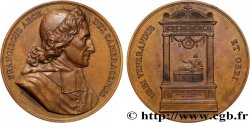fme_897854 - LOUIS XVIII Médaille, François de Salignac de La Mothe-Fénelon dit Fénelon, Monument érigé dans la cathédrale
90.00 €
Количество
Добавить в корзину

Тип Médaille, François de Salignac de La Mothe-Fénelon dit Fénelon, Monument érigé dans la cathédrale
Дата: 1825
Монетный двор / Город: 59 - Cambrai
Металл: bronze
Диаметр: 50,5 mm
Ориентация осей монеты: 12 h.
Гравер CAUNOIS François Augustin (1787-1859)
Вес: 55,82 g.
Век: lisse
Пуансон: sans poinçon
Комментарии о состоянии
Patine marron hétérogène, présentant des taches d’oxydation et de l’usure sur les hauts reliefs
Лицевая сторона
Аверс: легенда: FRANCISCUS ARCH. - DUX CAMERACENCIS..
Аверс: описание: Buste de Fénelon à droite.
Обратная сторона
Реверс: легенда: URBI VENERANDUS - ET ORBI. // MONUMENT ÉRIGÉ A FÉNÉLON / DANS LA CATHÉDRALE / DE CAMBRAI. // À L’EXERGUE : 1825..
Реверс: Описание: Monument funéraire érigé pour Fénélon, avec son gisant.
Комментарий
François de Salignac de La Mothe-Fénelon dit Fénelon, né le 6 août 1651 au château de Fénelon à Sainte-Mondane (Quercy) et mort le 7 janvier 1715 à Cambrai, est un homme d'Église, théologien, pédagogue et écrivain français.
Précepteur du duc de Bourgogne, archevêque de Cambrai (1695-1715), il s'opposa à Bossuet et tomba en disgrâce lors de la querelle du quiétisme, et surtout, après la publication de son roman, Les Aventures de Télémaque (1699), considéré comme une critique de la politique de Louis XIV. L'influence littéraire de ce roman fut considérable pendant plus de deux siècles. Fénelon a également écrit plusieurs autres ouvrages concernant la pédagogie ou bien didactiques (Traité de l'éducation des filles, Recueil des fables, Dialogues des morts, notamment)..
Précepteur du duc de Bourgogne, archevêque de Cambrai (1695-1715), il s'opposa à Bossuet et tomba en disgrâce lors de la querelle du quiétisme, et surtout, après la publication de son roman, Les Aventures de Télémaque (1699), considéré comme une critique de la politique de Louis XIV. L'influence littéraire de ce roman fut considérable pendant plus de deux siècles. Fénelon a également écrit plusieurs autres ouvrages concernant la pédagogie ou bien didactiques (Traité de l'éducation des filles, Recueil des fables, Dialogues des morts, notamment)..








 Cообщить об ошибке
Cообщить об ошибке Распечатать страницу
Распечатать страницу Отправить мой выбор
Отправить мой выбор Задать вопрос
Задать вопрос Consign / sell
Consign / sell
 Информация
Информация










